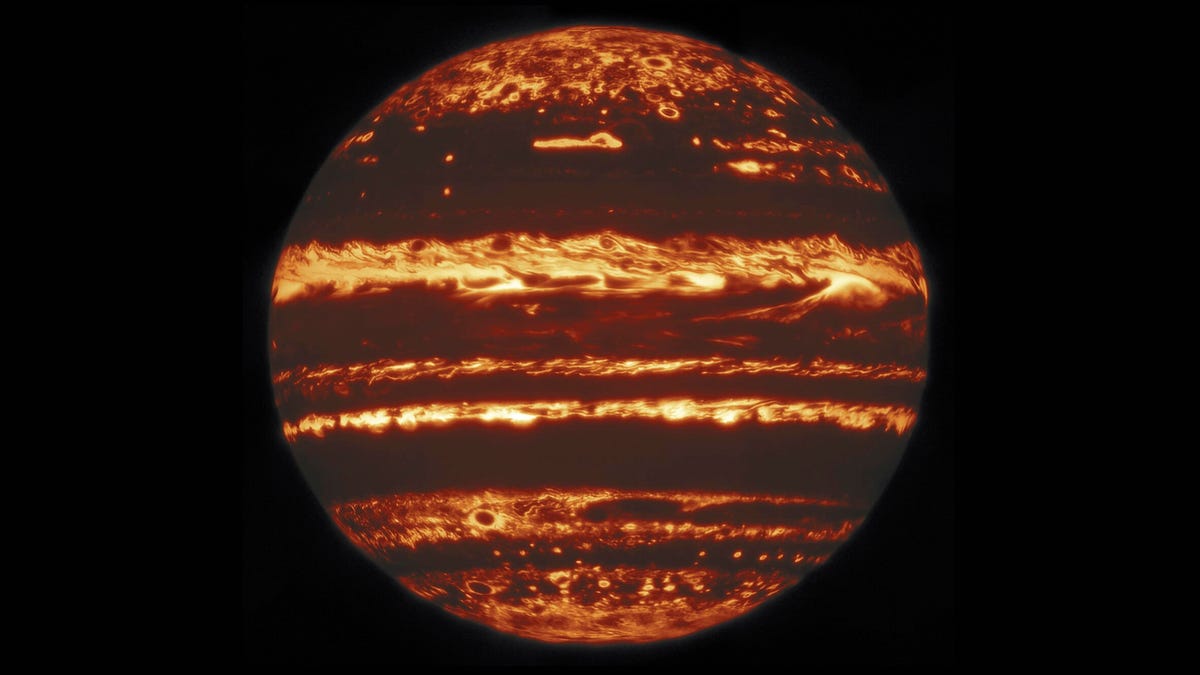Stunning, high-res photos of Jupiter find holes in the Great Red Spot
Holy Great Red Spot!

A snapshot of Jupiter in infrared light, taken by the Gemini Observatory in May 2019.
Jupiter, which lords over our solar system like Winston lords over The Continental in John Wick, is famous for the immense super-storm swirling in its gaseous atmosphere known as the Great Red Spot. Centuries of observation have revealed scant details about the gas giant's pockmark, but thanks to the work of two telescopes and the enterprising Jovian spacecraft, Juno, astronomers have been able to peer into the Red Spot with unprecedented clarity and reveal some of its inner workings.
A study, published in The Astrophysical Journal Supplement Series in April, utilized images taken by the Hubble Space Telescope, the Gemini Observatory and observations by Juno over a period of three years to examine the Great Red Spot, the biggest storm in the solar system, in ultraviolet and infrared light.
"We want to know how Jupiter's atmosphere works," said Michael Wong, an astronomer at the University of California, Berkeley and first author on the paper, in a press release. "This is where the teamwork of Juno, Hubble and Gemini comes into play."
The Gemini Observatory, which is located in Hawaii, was able to collect some of the highest resolution infrared images from a ground-based telescope yet by using a technique known as "lucky imaging". Images from ground-based telescopes can sometimes be blurred because of atmospheric effects, but lucky imaging can capture brief moments when those effects are at a minimum. The end result is images with a clarity rivalling the output of telescopes in space.
With lucky imaging, the blurs are gone! These photos of Jupiter were captured on April 8, 2019.
The unprecedented analysis shows the Spot, visible as a swirl of colour on Jupiter's face, looks "kind of like a jack-o-lantern" in infrared light, according to Wong. Thick clouds cover most of the planet's surface, so infrared light emanating from the heat generated deep inside Jupiter can't always escape. Hubble and Juno's imagers can't "see" as far into the planet as Gemini, so the ground-based telescope was critical to understanding what lurks within the Great Red Spot.
Hubble has imaged the region many times and noticed a dark band -- a sliver of black against the deep reds of the storm. Astronomers weren't sure exactly what this black band represented. With Gemini pointed at the Spot, the researchers were able to confirm these aren't different types of clouds, but holes. That's where the jack-o-lantern notion comes from.
Gaps in the immense storm allow for bright infrared light to beam out across the solar system. Thanks to the giant telescopic eyes at Gemini, we were able to see them.
"These coordinated observations prove once again that ground-breaking astronomy is made possible by combining the capabilities of the Gemini telescopes with complimentary ground- and space-based facilities," said Martin Still, an astronomy program director at the National Science Foundation, which funds the operation of Gemini.

